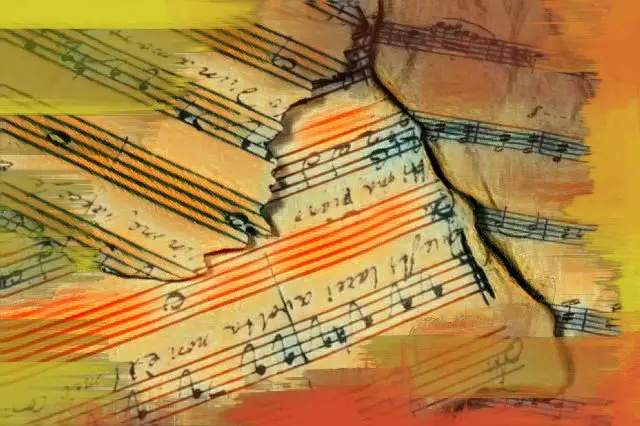If we didn't have intervals in music, we wouldn't have scale, melodies, or chord progressions. In a way, intervals are the foundation of music itself.
For too many new musicians, however, even basic music theory can seem intimidating.
In this small guide, we're going to teach you everything you need to know about intervals in music and how you can categorize them to make creating music more fun!
What Is An Interval?
An interval is the distance in pitch between two notes .
The smaller the interval, the less of a pitch difference there is between these two notes. On the other hand, the greater the interval, the greater the pitch difference between the two notes.
We can categorize intervals in many ways, though there are three main elements we like to look at when describing an interval:
- The pitch distance of the interval
- The quality of the interval
- Whether the interval is harmonic or melodic
Before we get into the nitty-gritty of it all, let's look at the two most basic types of intervals out there - tones and semitones.
Tones and Semitones
Tones and semitones (whole steps and half steps, respectively) are the foundational intervals.
To craft various scales and chords, we'll use a range of tone and semitone combinations.
Semitones are the smallest interval of the bunch. People often refer to the semitone as a half-step.
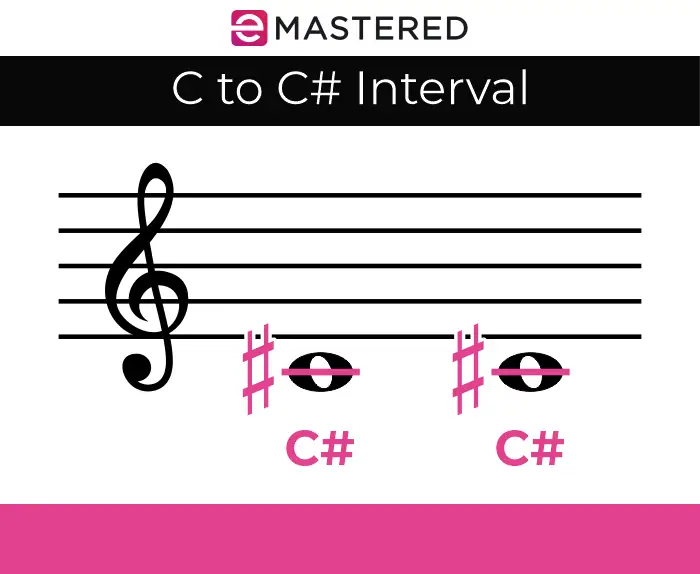
So, for example, if you are on the note C on your keyboard and move to the note C# , This is a half-step.
Tones are double the size of semitones, and many refer to them as whole steps. You can think of this interval jump as two semitones.
So, for example, if you are on the note C on your keyboard and you move to the note D , you're moving a whole step.
Interval Names
Now that you have a decent understanding of the two most basic intervals, let's take a look at a few larger intervals and how we can define them.
To define an interval, we use numbers. The numbers are based on how many musical letter names are between the two notes.
Let's say we have the notes C and D right next to each other, and we're trying to figure out the interval name, we know that the fact that C and D are two letter names apart makes it a second .
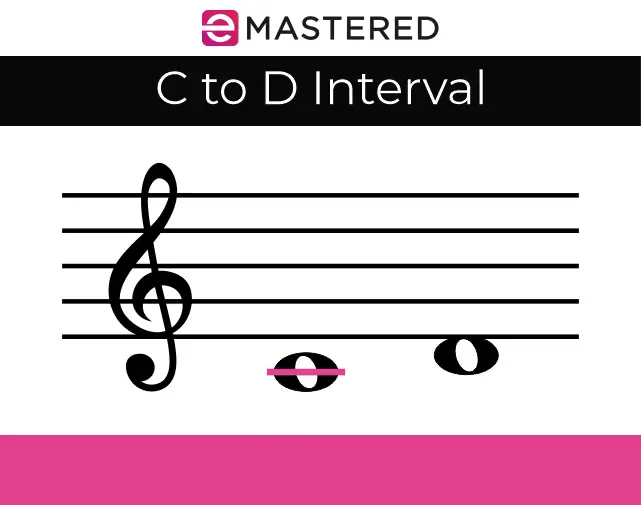
However, if we take the note D and move it up to an E , the interval becomes a third since C and E are three letter notes apart.
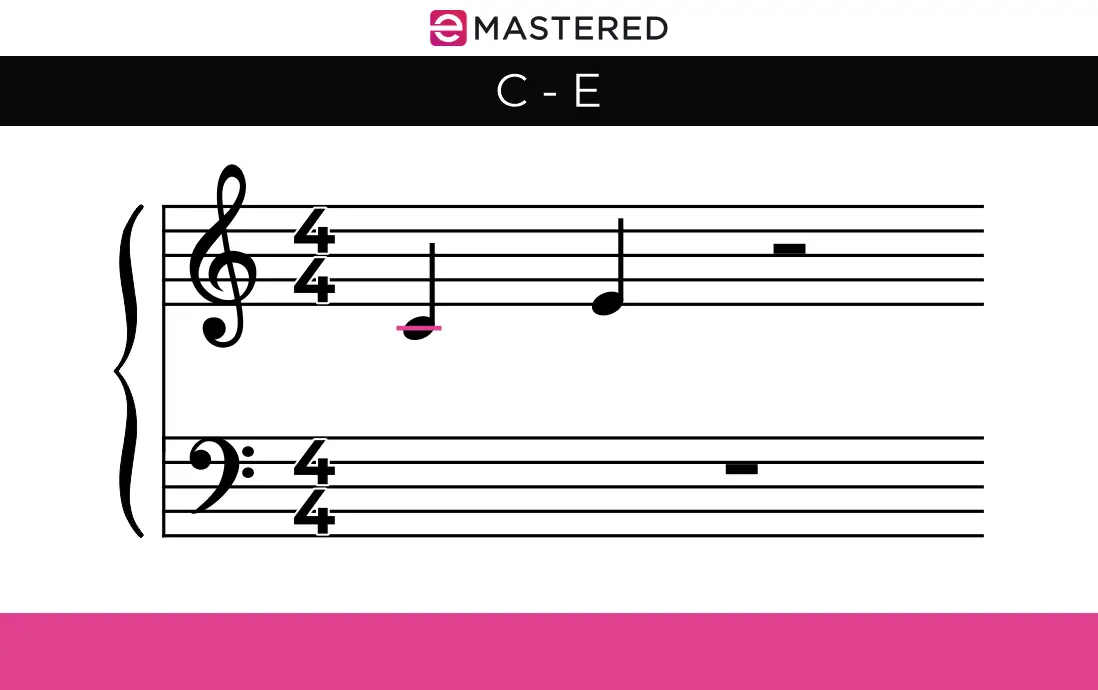
If we move that E up to an F , the interval becomes a fourth.
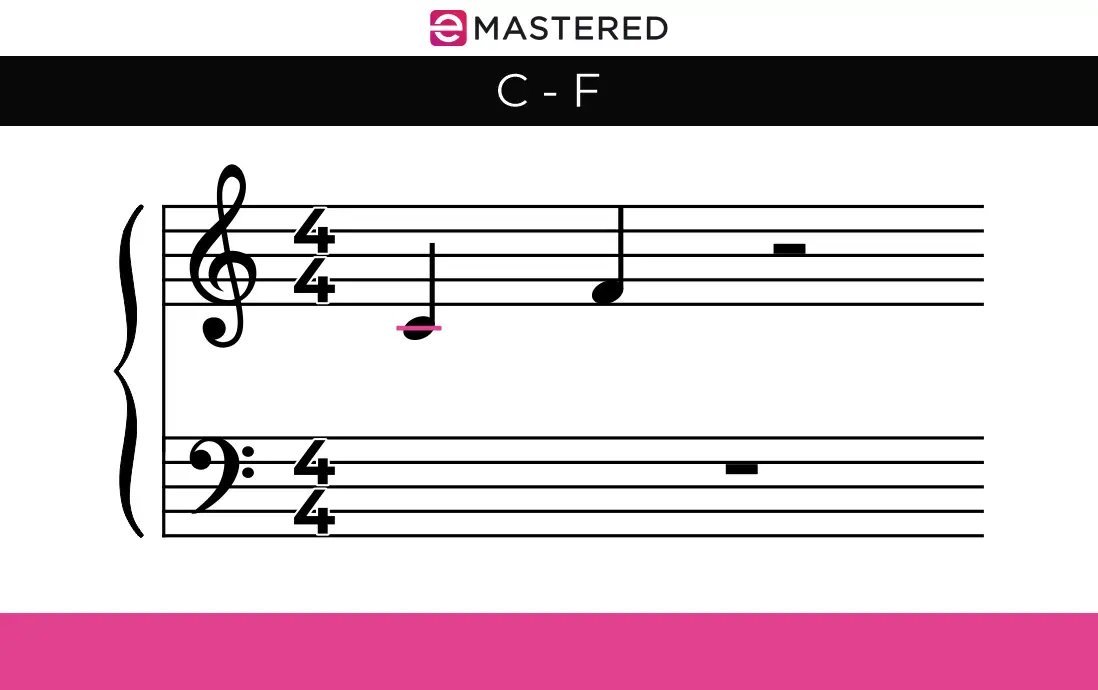
If we move that F up to a G , the interval becomes a fifth.
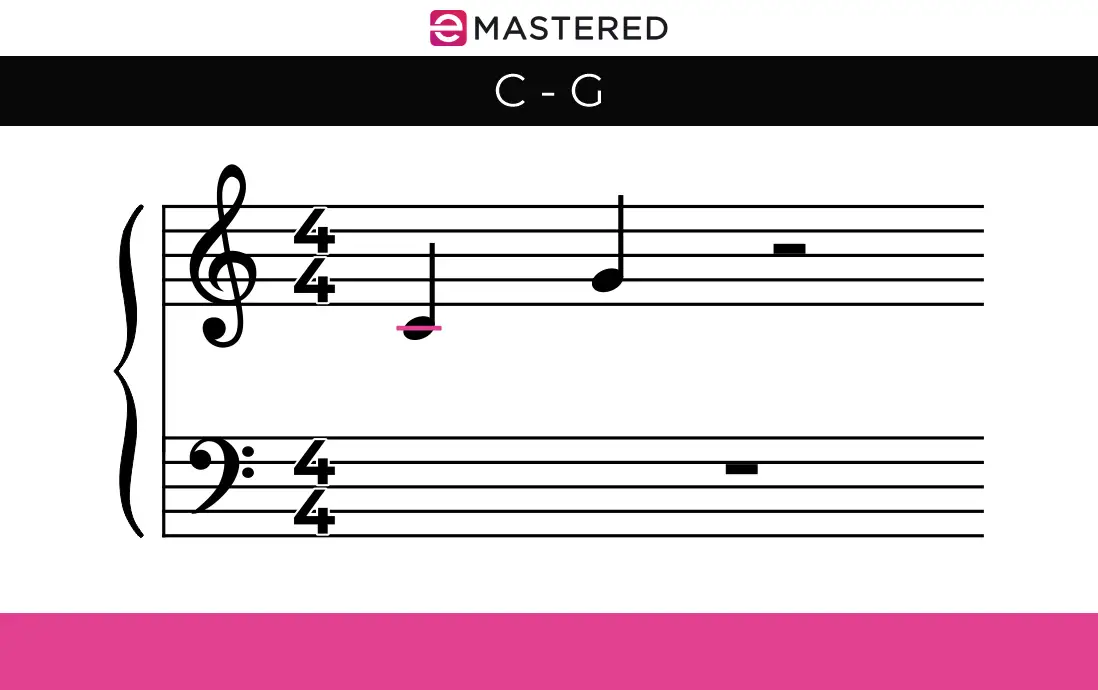
If we move that G up to an A , the interval becomes a sixth.
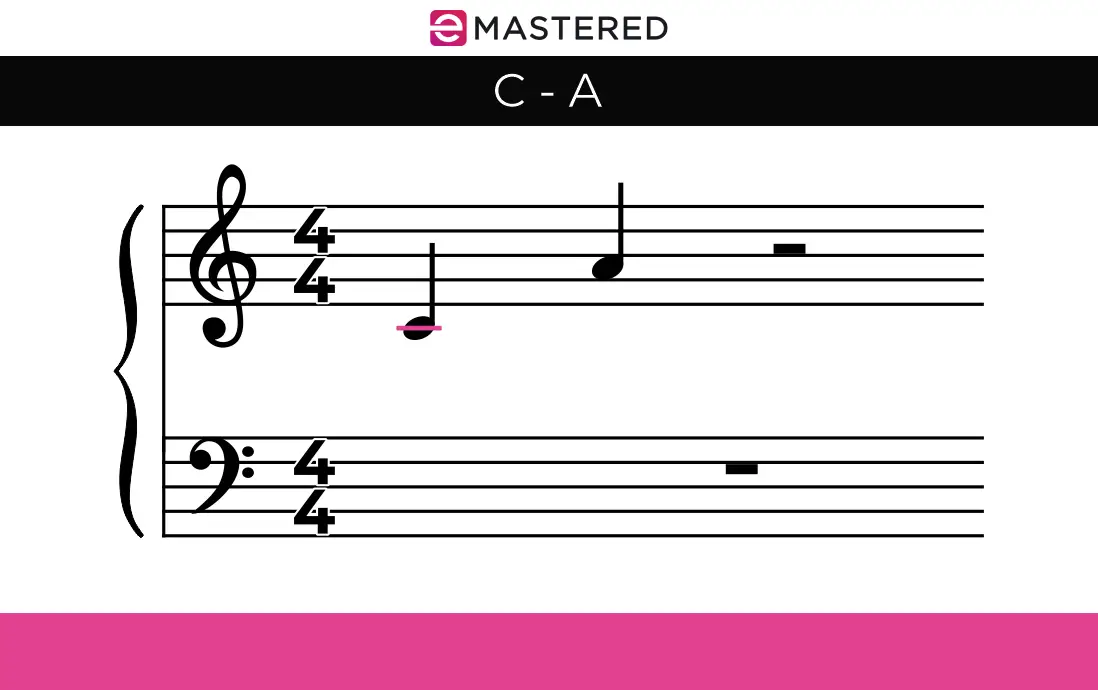
If we move that A up to a B , the interval becomes a seventh.
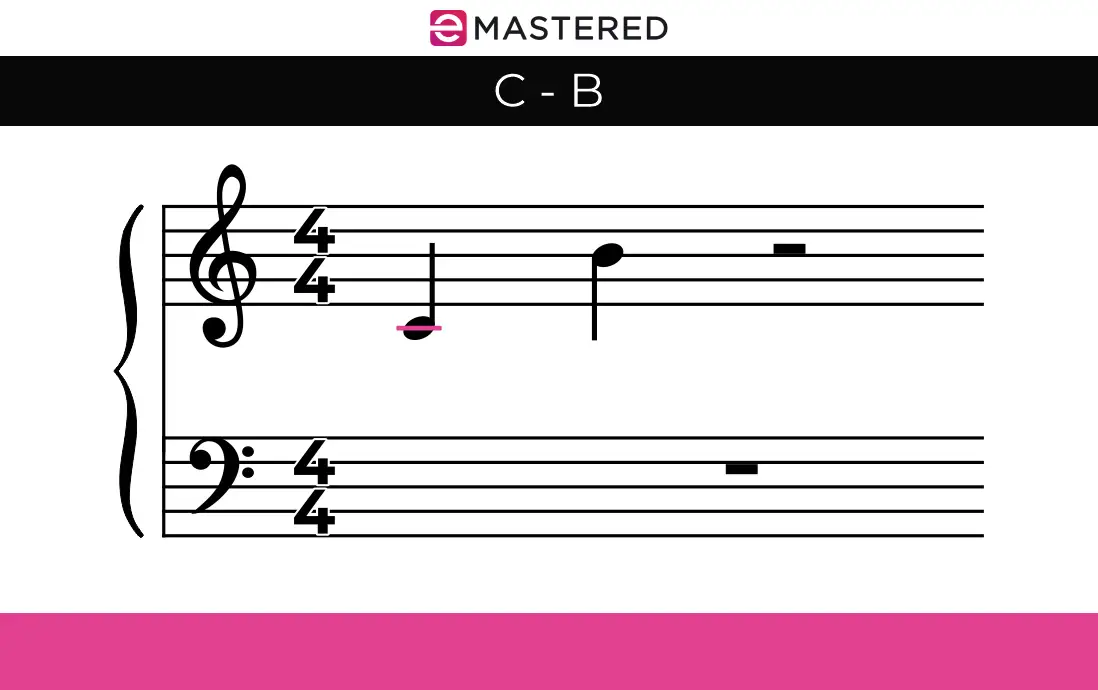
If we move that B up to a C , the interval becomes an eighth or an octave
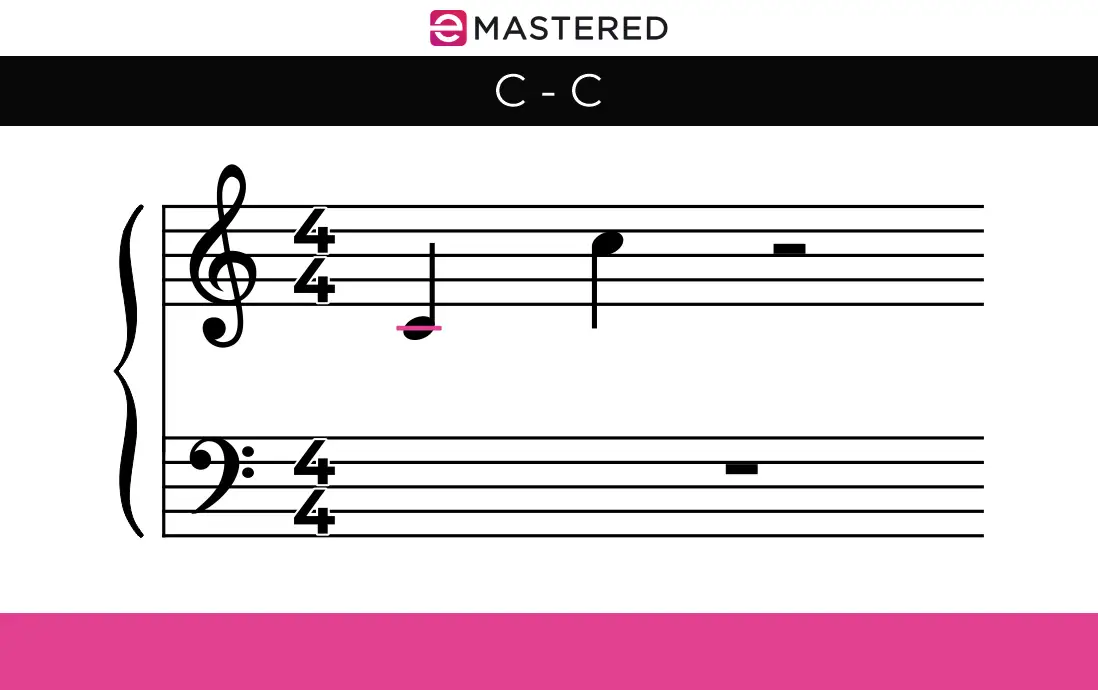
It's also important to note that we have an interval name for when we're looking at two notes that are the same. This interval is called unison .
For example, two instruments in a score might play the same note at the same time.
Interval Quality
Interval quality is the next element to determine.
When referring to intervals, we don't simply refer to their numbers. Instead, we distinguish them based on their quality.
If we look at the photo below, we can see that both of the intervals on the staff are thirds.
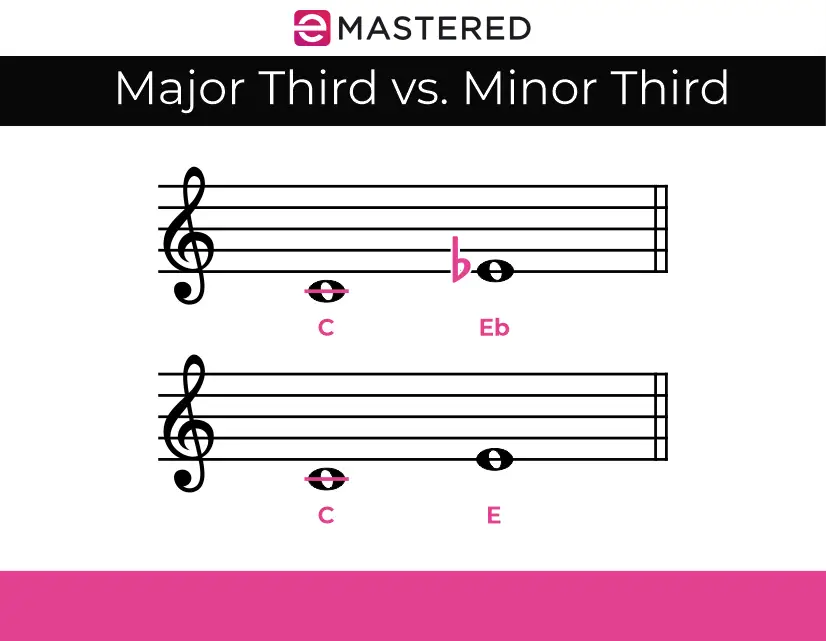
The first interval has three letter notes moving from C to Eb (C-D-Eb).
The second internal also has three letter notes moving from C to E (C-D-E).
To distinguish these two intervals from one another, we have to figure out what quality separates them.
There are a few types of qualities in the world of intervals, including:
- Perfect intervals
- Major intervals
- Minor intervals
- Augmented intervals
- Diminished intervals
Before getting into how these different types of intervals work, let's take a look at the major scale .
Each note in the major scale, starting from the tonic or root note, makes up a major interval or perfect interval:
Here are the intervals in the C major scale:
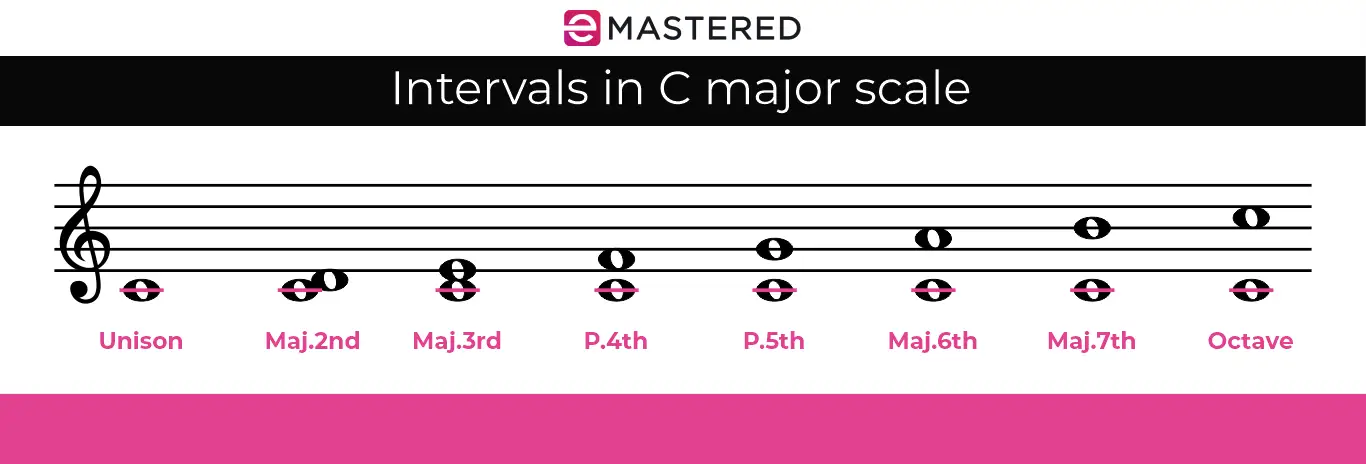
Perfect Intervals
We refer to three types of intervals as perfect intervals , including:
- Perfect fourth
- Perfect fifth
- Perfect eighth (octave)
These are intervals that occur naturally in the major scale. We refer to them as "perfect" intervals due to the way they sound together and the frequency ratios they make up.
There are fourths and fifths that aren't perfect intervals, which we'll get into later.
However, to give you a better visual, here are all of the perfect intervals in music theory:

Major Intervals
We refer to four types of intervals as major intervals , including:
- Major second
- Major third
- Major sixth
- Major seventh
If you're looking at the major scale, and the upper note is not a perfect interval, then you can determine it is a major interval.
Whenever you're looking for the interval number, you can start with the lowest letter in the interval and label that as one (root or tonic). Then, you can count how many letters it takes to get to the higher note.
Here are the major intervals in the C major scale:
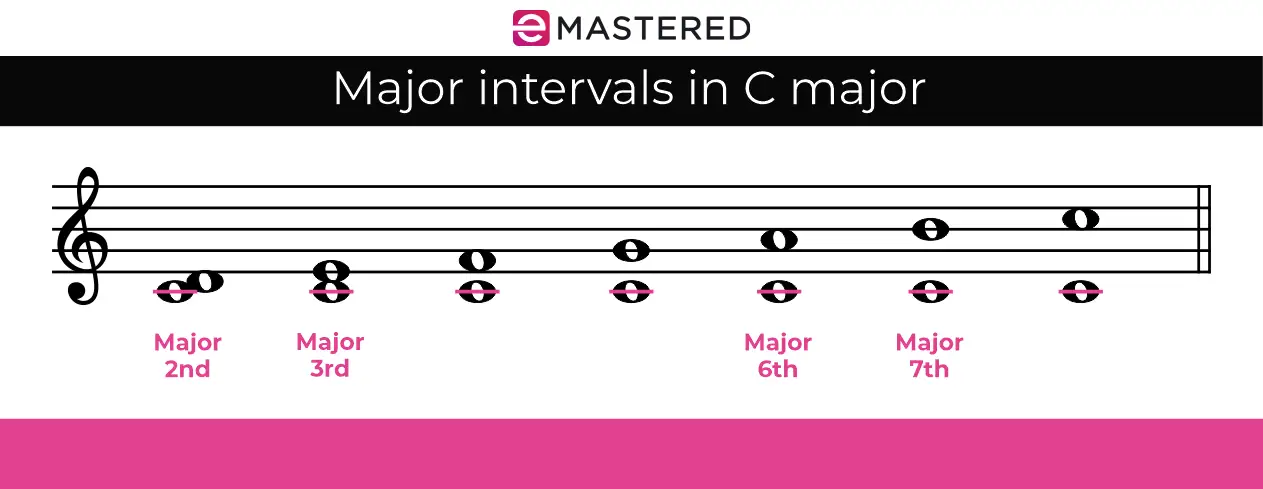
Of course, the same thing goes for any major scale, not just C major.
If you're starting on the tonic and moving to a note above it, it will either be major or perfect.
Minor Intervals
Here's where things start to get a bit tricky. If we lower the top notes of any of our major intervals by a half-step or semitone, they become minor intervals .
Let's say that we have the interval C to E , as we discussed above. This interval is a major third. However, if we lower the E with a flat, it becomes Eb . The interval, which is now C to Eb, becomes a minor third.

Since we only have four possible major intervals in the major scale, we also only have four possible minor intervals, including:
- Minor second
- Minor third
- Minor sixth
- Minor seventh
Before we move on, let's summarize what we've already learned:
- If you're looking at the upper note in a major scale starting from the tonic or root note, it can only be a major or perfect interval.
- If the top note in the major scale is a fourth, fifth, or eighth, then you will have a perfect interval .
- If the top note in the major scale is a second, third, sixth, or seventh, then you will have a major interval .
- If you take the top note of a major interval and lower it by a semitone or half-step, then you will have a minor interval.
Augmented Intervals
When you extend a major or perfect interval by a half-step or semitone, though keep the same letter name, you get an augmented interval .
So, for example, if we took a perfect fifth interval, such as C to G , and we extended the G to a G# , we would make it an augmented fifth interval. The same thing would go if we took a C to D major second interval and extended the D to a D# . This interval would be an augmented second interval.
Look at the photo below to get a better idea of what augmented intervals look like, and feel free to take a second and play these on a keyboard if you have one around to get accustomed to how they sound.
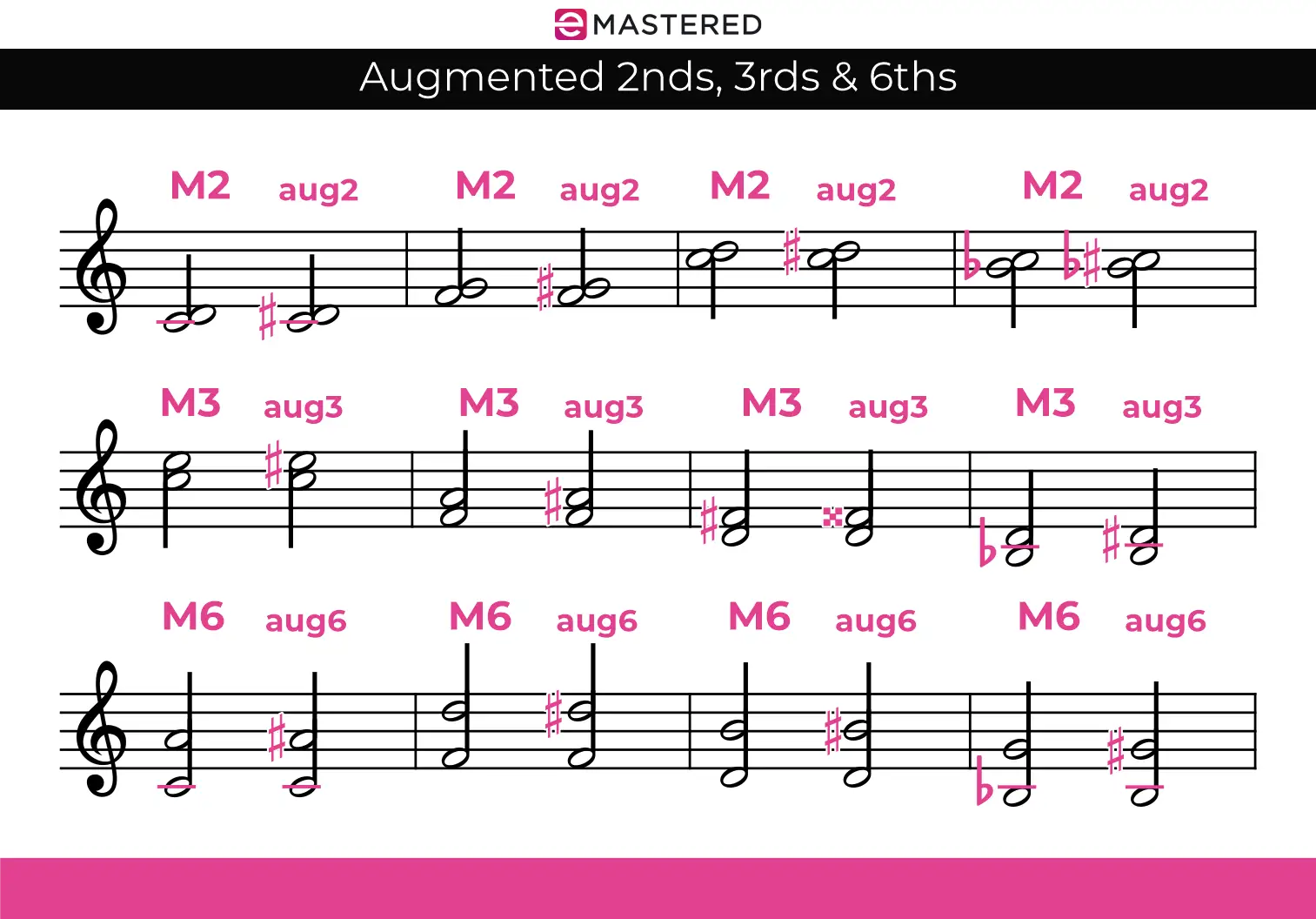
So, what happens if we put a flat on the higher note in the interval instead of a sharp?
In that case, we get what's called a diminished interval.
Diminished Intervals
If we put a flat on any of the perfect intervals (fourths, fifths, or eighths), they become diminished intervals, rather than minor intervals.
For example, let's say we have the notes C to F , which is a perfect fourth.
If we were to put a flat on the note F to make it an Fb , we would get a diminished fourth.
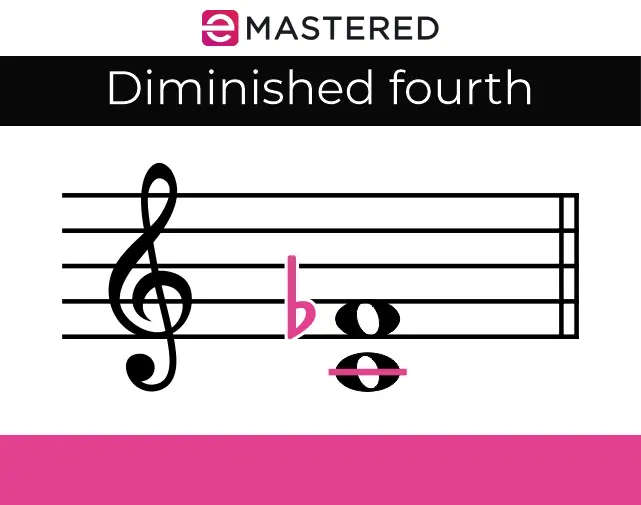
If we put a flat on a minor interval to lower the top note by a semitone, we get a diminished interval as well. For example, if we have the notes E to D , which is a minor seventh, and we put a flat on the D to lower it by one semitone, we would get a diminished seventh.
If we wanted to make a major interval a diminished interval, we would have to flatten the top note by a whole-step instead.
Wrapping Up Standard Music Intervals
At this point, you should have a pretty decent understanding of how intervals work in music. Here's a small chart you can take with you to remember the various intervals from unison to octave:
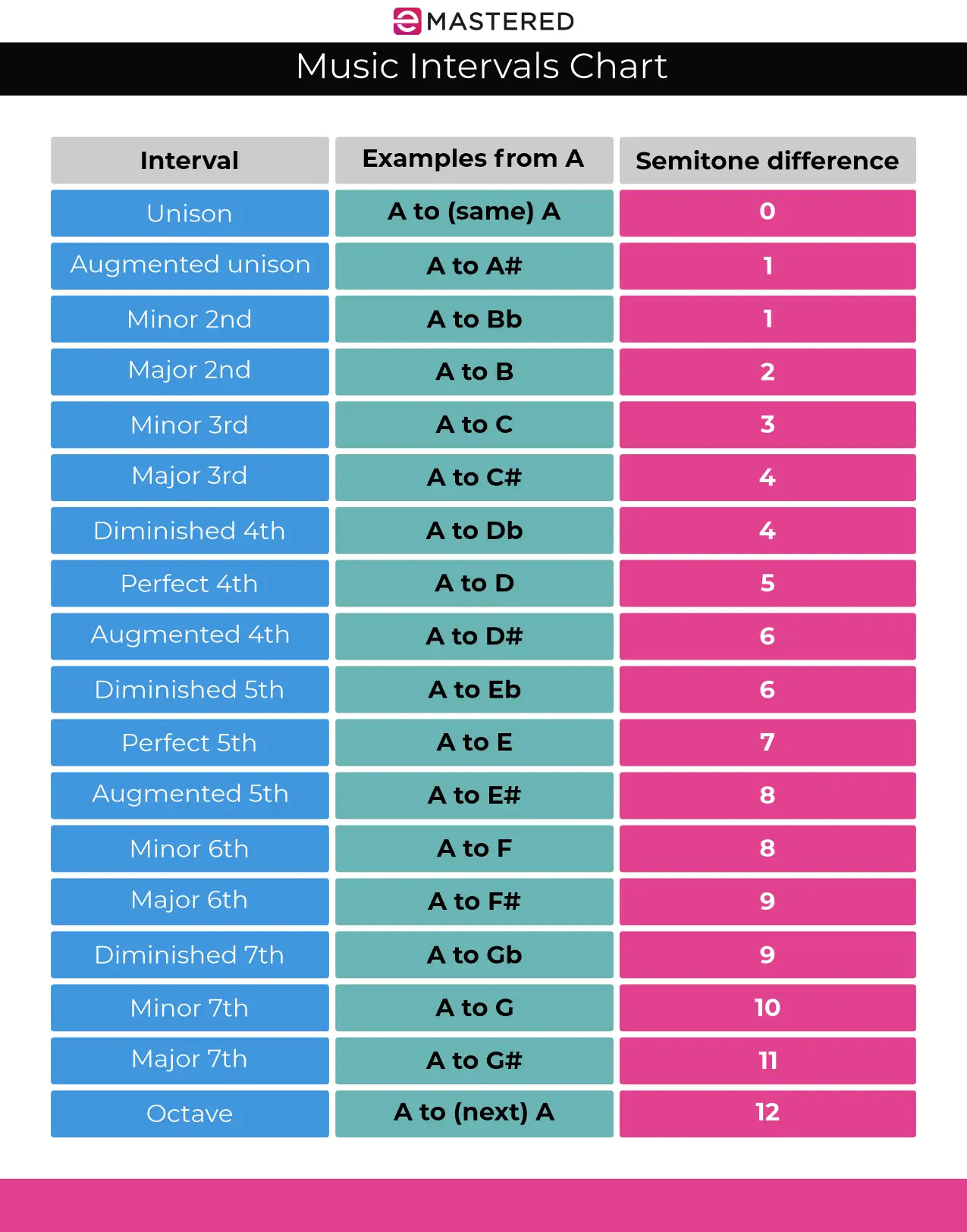
Compound Intervals
Up until now, we've discussed what simple intervals are .
A simple interval is one that is within one octave. However, when we step outside the bounds of an octave, we get into what are called compound intervals .
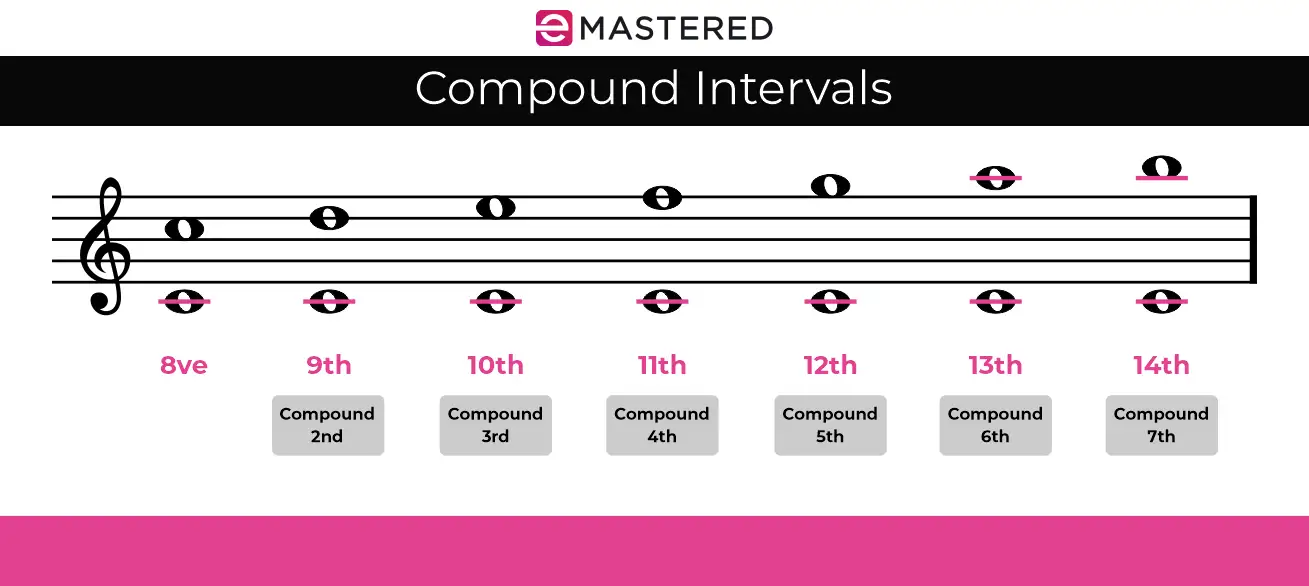
There are a few different ways to discuss compound intervals.
The first method is by using the word "compound" in front of the interval name.
For example, let's say that we had the interval C to E , which we now know is a major third.
If we were to take the top note E and place it one octave higher, it would become a compound major third.
However, you can also name compound intervals by using number names above eight.
In the same example above, the C to E with an E that is an octave higher would be a major tenth instead of a compound major third.
Harmonic and Melodic Intervals
Beyond using numbers and quality to define intervals, music theorists also often categorize intervals in two different groups, including:
- Harmonic Intervals
- Melodic Intervals
While they use the same terms, harmonic intervals and melodic intervals are different from harmonic and melodic minor scales.
Harmonic Intervals
A harmonic interval is an interval where the two notes are played together or in "harmony."
If you look at the photo below, you'll see a C and E played at the same time to create a harmonic major third.
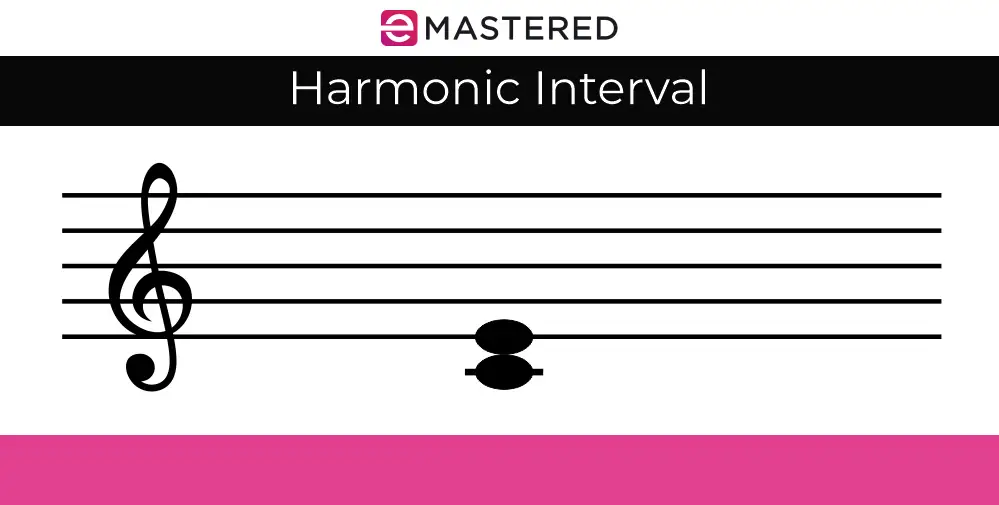
Melodic Intervals
On the other hand, we have melodic intervals wherein one note is played after another. Because these notes are said to be part of a melody, they are called melodic intervals.
If you look at the photo below, you'll see a C and E played in the melodic form to create a melodic major third.
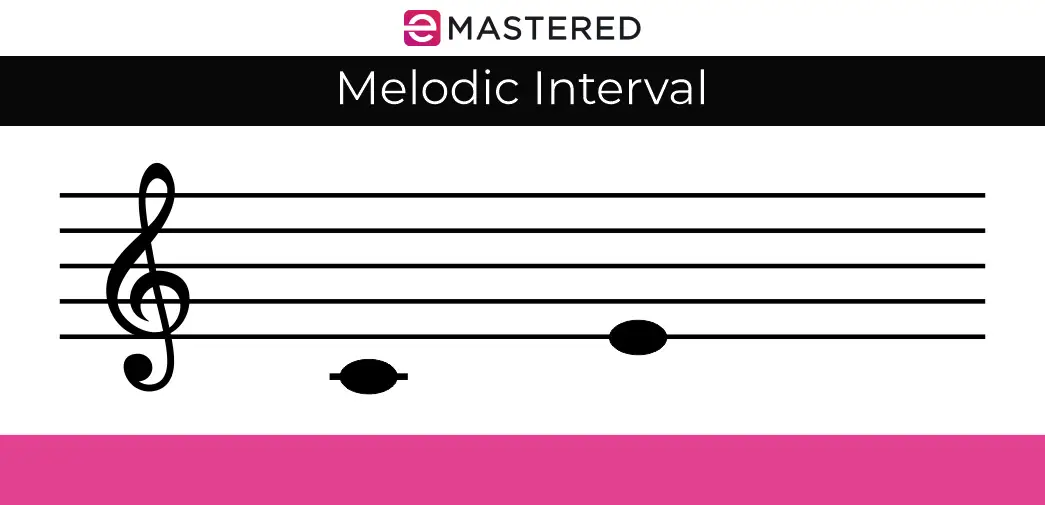
Intervals In Music
When it comes to identifying intervals in music, the first thing you must do is understand their theoretical concepts, which we've already covered above. Once you feel comfortable with how intervals work in general, you can start learning how to identify them by ear.
Let's take a small journey through the various intervals in music and discuss some popular songs to help you identify them with ease.
Minor Second
The minor second is the smallest interval in western music theory.
With a half-step or semitone between the two notes, you get a dissonant and ominous effect when the two notes are played next to each other or at the same time.
One of the best examples of a minor second is the theme song from the movie "Jaws."
The introductory notes in the song move up and down in minor second fashion to induce terror in the hearts and minds of listeners. Even decades later, the theme song to this movie is still instantly recognizable!
Major Second
It seems sort of silly that we could simply take the top note in the ominous minor second and raise it by a half-step to get the starting notes of one of the happiest songs on Earth!
In the first line of "Happy Birthday," you can hear an ascending and descending major second.
The ascending major second is Hap py - Birth , while the descending major second is Birth-day .
Minor Third
The minor third can be found in the traditional English song, "Greensleeves." There are many minor thirds throughout this song, though you can hear the first ascending minor third interval in the very beginning of the song.
For a descending minor third, one of the best song examples comes from "Hey Jude," arguably one of the most popular Beatles songs of all time.
You can hear this descending minor third on the first line of the song moving from "Hey" to "Jude."
Major Third
Moving back into the happier intervals, one of the best song examples of the major third comes from the old American spiritual, "When the Saints Go Marching In."
The ascending major third can be heard in the first line of the song, from "Oh" to "When."
On the other hand, the best example of a descending major third comes from the African-American spiritual, "Swing Low, Sweet Chariot."
You can hear the descending minor third on the first line of the song as it moves from "Swing" to "Low."
Perfect Fourth
Next to the perfect fifth, the perfect fourth is one of the most stable intervals in western music theory.
One of the best examples of the perfect fourth in popular music comes from the 18th-century Christian Hymn, "Amazing Grace."
You can hear this ascending perfect fourth in the first syllable of the song in the word "A- maz -ing."
An excellent example of a descending perfect fourth interval is from the beloved Christmas carol, "O Come, All Ye Faithful."
This descending fourth can be heard in the first line, from the words "O Come" to "All."
Tritone
The tritone is one of the most unusual and unsettling intervals in western music. For many years, people referred to it as the "Devil's interval." A tritone sits right in-between the perfect fourth and perfect fifth intervals. It can either be referred to as an augmented fourth or diminished fifth.
One of the best examples of the tritone in western music is the theme song from The Simpsons. You can hear the tritone on the very first line, "The- Simp -sons."
As for a descending example of the tritone, listen to the song "Even Flow" by Pearl Jam.
The vocal line in the main verse starts with a prominent tritone interval.
Perfect Fifth
The perfect fifth is one of the most stable intervals in western music theory. You'll find it used heavily in basic triads, and it makes up the majority of chord progressions in popular music.
When it is played as a harmonic interval, it creates a very powerful sound. On the other hand, when used in melody, you can create an uplifting or triumphant sound.
One of the best examples of the perfect fifth can be found in the theme song for Star Wars .
For a descending perfect fifth interval example, you can listen to the first few notes in the theme song for The Flinstones . The descending perfect fifth can be heard on the first "Flin- stones ."
Minor Sixth
Once we get above the perfect fifth, intervals start to feel much more "melodic." The distance between the two notes in minor sixth intervals and above are much larger, which is where song examples start to become far more helpful.
One of the best examples of the minor sixth in modern popular music comes from the band FUN and their hit song, "We Are Young."
You can hear it in the chorus on the line "Set the world on fi- re ."
Another great example of a minor sixth in music that moves between an ascending and descending minor sixth comes from the classic Scott Joplin ragtime tune, "The Entertainer."
You can hear the minor sixth moving up and down after the first couple of pickup notes.
Major Sixth
The major sixth interval is another pretty large jump where a good song example can be helpful.
One of the best examples of a major sixth in music comes from the traditional Scottish folk song, "My Bonnie Lies Over the Ocean."
You can hear the ascending major sixth in the first few syllables of the main line, "My Bon -nie."
As for a good example of a descending major sixth, you can use "Man In The Mirror" by Michael Jackson.
You'll find a descending major sixth in the chorus on the first two syllables, "I'm start -in with the man in the mirror."
Minor Seventh
One of the best examples of the minor seventh in music comes from West Side Story .
You can hear this ascending major seventh in the song "Somewhere" on the line "There's a place for us."
As for a descending minor seventh, one of the most popular examples comes from "Watermelon Man" by Herbie Hancock. The very first two notes in the song make up a minor seventh interval.
Major Seventh
The major seventh interval is an odd interval that isn't often found in popular music, as it is so close to the octave. Of course, you'll often hear the interval in chords, especially for a bit of added color.
One of the most popular examples of the major seventh as a melodic interval is from the A-Ha classic, "Take On Me."
You can hear the major seventh interval in the first line of the chorus, "Take On."
As for a descending major seventh, one of the best examples comes from the melody in Cole Porter's song, "I Love You."
The first few notes of the melody start with a bold major seventh drop.
Octave
The octave is the largest simple interval leap in music theory. One of the best examples of this octave jump comes from the popular song, "Somewhere Over the Rainbow."
The chorus has an octave leap between the two syllables of "Some- where ."
One of our favorite descending octave reminders comes from the theme song to the popular 90s sitcom, Doogie Howser, M.D. You can hear it in the synth line at the very beginning of the song.
Final Thoughts
Intervals are some of the most important music theory tools around. Without these fundamental music theory tools, you can't get very far. From melodies to chords to progressions and beyond, you can think of intervals as building blocks.
Now that you've made it through this article, you should have a good idea of how to recognize intervals in the music you love and use intervals as you write your own music.


